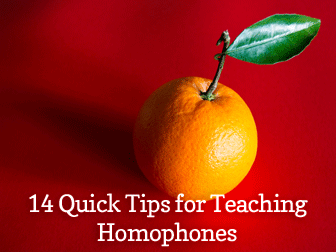14 Quick Tips for Teaching Homophones


Try one, two or more and see how quickly your students catch on to these word-based conundrums.
You Are So Punny
Explain the concept of puns to your ESL class, that they are words or phrases that sound similar to one word but in effect mean something completely different. Give your class a couple of examples of riddles based on puns. For example, you might ask, “What room has no doors and no windows?” The answer is a mushroom. You could also ask, “Why didn’t the skeleton go to the dance?” The answer to that question is he had nobody to take.
Then divide your class into two groups and have each group of students write pun based riddles on index cards. You may want to give them a book of riddles or refer them to a website where they can find lists of riddles in English. They should write the question on one card and then the answer on another card. Collect the cards from each group and shuffle them. Then give the question set to each group who did not write them. Your students should read the questions to see if they are able to guess any of the answers to the riddles. Remind them that the riddles are based on puns. If either group has any answers, give them an opportunity to ask the other group if those answers are correct. After each group has tried to guess the answers to the riddles, give them the shuffled answer cards, and give them time to match the correct answers to the questions. Was either group able to get the answers to any of the riddles? Do they understand the answers now that they have them? Review with your class the riddles and answers and explain the humor if necessary.
Rhyme Time
This simple little game is a good excuse to spend some time reviewing rhyming words with your class! If your students are new to rhyming or if it has been a while since your class has focused on how pronunciation affects rhyme, remind them that a rhyming pair is made with two words whose vowel and final consonant are the same but whose initial sounds are different. Give some examples to your class such as fat cat, tan man, or blue shoe.
Once you have reviewed rhyming pairs with your class, they are ready to play the game. In this game, you or your students will write a clue to a silly rhyming pair. In the clue, the writer should use synonyms to describe the rhyming pair that is the answer. For example, you might give the clue, “foot wear which has travelled through a berry patch” and the answer would be blue shoe. A shopping center that is twenty stories high would be a tall mall. Have your students think up two or three of their own clues that can be used to discypher rhyming pairs. Have each person fold one piece of paper in half for each clue and write the description on the top of the paper (imagine writing on the front of a card). Your students should then write the answer to the clue on the inside of the folded paper (imagine the inside of a card). Display all of the cards on a bulletin board within reach of your students. In their free time, they will enjoy reading the clues and trying to think of the rhyming pair. Once they think they have the answers or when they have been stumped, they can lift the flap and check the answers. If you like, have your students write a new set of clues to rhyming pairs every few weeks and change out the cards and clues to keep your students’ interested.
Take a Look Around You
In this activity, your students will create riddles of their own to describe their classmates. Write each student’s name on a slip of paper and put it in a hat or bag. Then go around the room and have each of your students choose one of the names from the hat. Without telling whose name they have, challenge your students to write a riddle using five adjectives that describe the person whose name they have chosen. They should start their description with, “I am…” and continue with one or more sentences. Encourage your students to be as specific as they can. For example, a person may write, “I am smart and studious. I am intelligent, athletic and energetic.” Give your students several examples that you have written which describe people that they would all know. If time allows or if the need arises, this game is a good opportunity to review parts of speech. Your students may be in special need of a review of adjectives and adverbs.
As an extension of this activity, challenge your students to take the descriptions they have written and use synonyms for the adjectives they have chosen. How specific can they be in their clues? Can using one synonym or another alter the meaning of the clue? To make the clues even more interesting, show your class how to use a thesaurus to find more specific words for their descriptions! If your students come across words with which they are not familiar, encourage them to check an English/English dictionary to determine how each word varies from the others listed there.
Either way, they will be using the language skills and vocabulary they already know to acquire more.